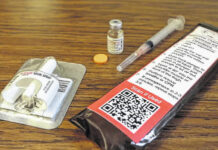LUMBERTON — Free screenings for peripheral arterial disease will be offered at Southeastern Wound Healing Center on Friday.
The screenings will be co-hosted by PrivilegesPlus and Southeastern Health Heart and Vascular,from 1 to 3 p.m. Participants are asked to pre-register, however, some walk-in screens will be available. To pre-register or for more information, call 910-671-5018.
Southeastern Wound Healing Center is at 103 W. 27th St.
Peripheral arterial disease is a condition that develops when the arteries that supply blood to the internal organs, arms and legs become completely or partially blocked as a result of atherosclerosis. Possible side effects of atherosclerosis include angina and heart attacks if the coronary arteries are involved; strokes and transient ischemic attacks if the carotid and vertebral arteries are involved; and claudication, non-healing leg ulcers and critical limb ischemia if the lower extremity arteries are involved.
One in 20 Americans older than 50 have peripheral arterial disease and the disease affects eight to 12 million people in the United States. Slightly more men than women have it. Common risk factors include high cholesterol, smoking, high blood pressure, diabetes, atherosclerosis and age. An estimated one out of every three people with diabetes over the age of 50 has the disease.
Health-care professionals use many avenues for diagnosing the disease, such as medical history, tobacco use, physical exams and diagnostic tests. An ankle-brachial index test may be performed. An ABI test involves a comparison between a blood pressure reading in the ankles and a blood pressure reading in the arms. An ABI can help diagnose PAD, but it cannot identify which arteries are narrowed or blocked. A Doppler ultrasound test may be done to see which artery or arteries are blocked.
Chronic toe and foot sores are common in people with PAD, as are cramping, numbness, weakness or heaviness in the leg muscles. Many patients with PAD do not experience symptoms.
Southeastern Wound Healing Center recommends the following action steps to help manage PAD:
— Lifestyle changes such as quitting smoking, correcting blood pressure and cholesterol numbers: Managing these conditions can help improve blood circulation.
— Develop healthy eating habits and an exercise plan: Exercising can help increase the circulation and reduce pain in the lower extremities. Walking, hiking and bike riding are good exercise options. A personal trainer can help tailor a custom workout plan that best fits a person’s needs.
— Medications: Always consult with a physician about which medications may help PAD and if they are needed.
— Special procedures and surgeries: In some severe cases of PAD, surgery may be needed to open arteries that have narrowed.
To schedule an appointment, call 910-735-8912 or logon to www.southeasternhealth.org/woundhealing. No referral is required.






